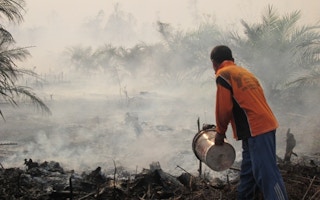The world’s endangered peatlands need better protection or else climate change will spiral out of control, environmentalists said on Thursday at the launch of a global initiative to help prevent their destruction.
Peatlands cover just 3 per cent of the world’s land surface, but contain twice as much carbon as the entire biomass of the world’s forests. If they are drained or burned, that carbon is released as greenhouse gas into the atmosphere.
Fifteen per cent of peatlands have already been drained, according to environmental data, and many more are under threat of being destroyed to make way for palm oil crops, pulp wood production and other uses.
If this is allowed to happen, the resulting increase in emissions could raise temperatures enough to thaw permafrost - frozen soil, rock or sediment.
“
It is critical we do not reach the tipping point that will see peatlands stop sinking carbon and start spewing it into the atmosphere, destroying any hope we have of controlling climate change.
Erik Solheim, head, United Nations Environment Programme
This would in turn cause peatlands in Arctic and sub-Arctic regions to also release their carbon, according to the U.N. Environment Programme (UNEP) which is leading the initiative launched at international climate talks in Marrakesh.
“It is critical we do not reach the tipping point that will see peatlands stop sinking carbon and start spewing it into the atmosphere, destroying any hope we have of controlling climate change,” Erik Solheim, head of UNEP, said in a statement.
He said even with current pledges under the Paris Agreement to limit global warming to “well below” 2 degrees Celsius (3.6 Fahrenheit) above pre-industrial times, the world was heading for a global temperature rise of over 3 degrees Celsius this century.
“This will cause misery and chaos for millions of vulnerable people, so we cannot afford to let any opportunity to reduce emissions slip by,” Solheim said.
The Paris Agreement, which came into force on Nov. 4, seeks to phase out net greenhouse gas emissions by the second half of the century.
Toxic haze
Peatlands are made up of partially decayed plant material, accumulated under water-logged conditions over long periods of time. They are mostly present in the northern hemisphere, covering large areas in North America, Russia and Europe.
Peat is burned as fuel, and is highly prized as agricultural land when drained. But it is also highly flammable once drained, and has caused major fires in Indonesia and Russia in recent years.
Last year, the toxic haze from peat fires in Indonesia affected 43 million people, UNEP said.
Countries drawing up plans to implement the Paris Agreement can kick-start major cuts in emissions by protecting peatlands, said Martha Rojas-Urrego, secretary general of the international Ramsar Convention on wetlands conservation.
However only a few countries have included plans to manage peatlands in their climate change national strategies, so more action was needed, Rojas-Urrego said.
Countries taking part in the initiative include Indonesia, Peru and the Republic of Congo. It is backed by the U.N. Food and Agriculture Organisation, Wetlands International and the European Space Agency among other organisations.
This story was published with permission from Thomson Reuters Foundation, the charitable arm of Thomson Reuters, that covers humanitarian news, women’s rights, trafficking, corruption and climate change. Visit http://news.trust.org.










